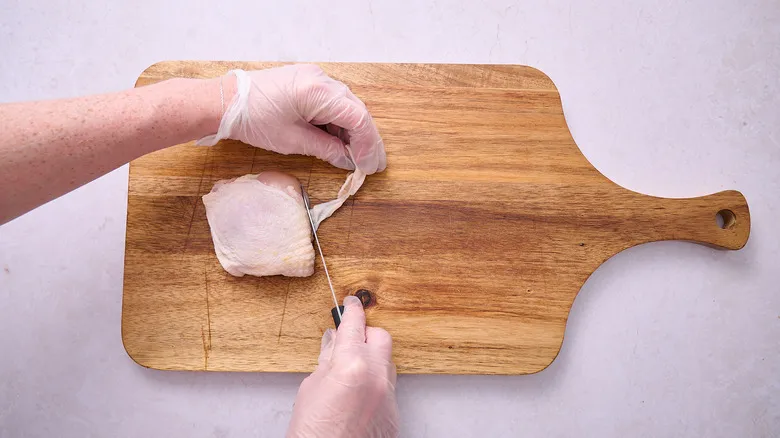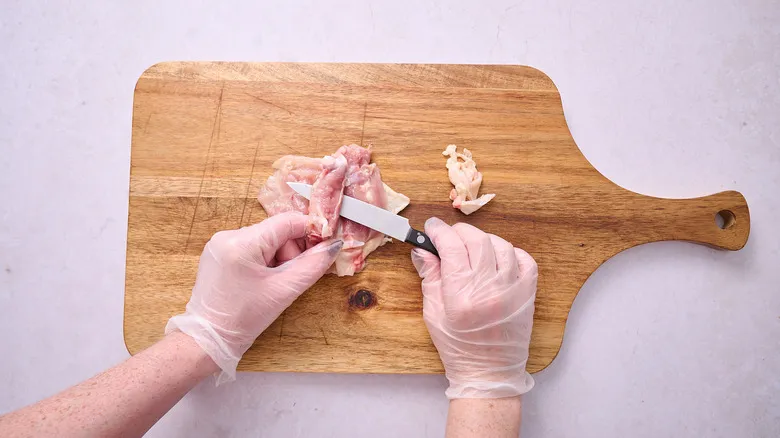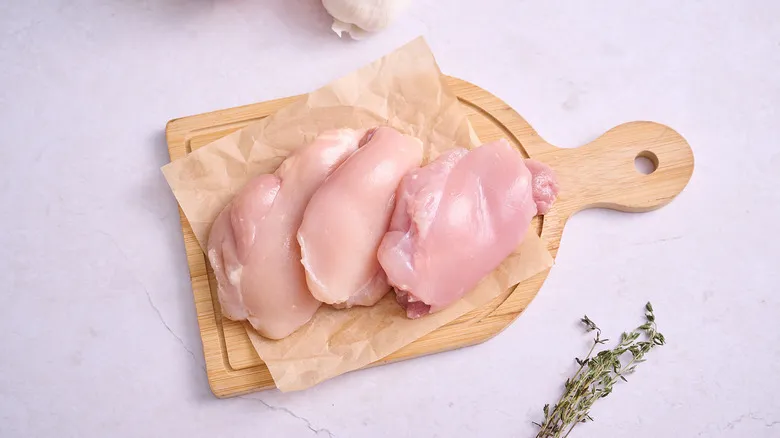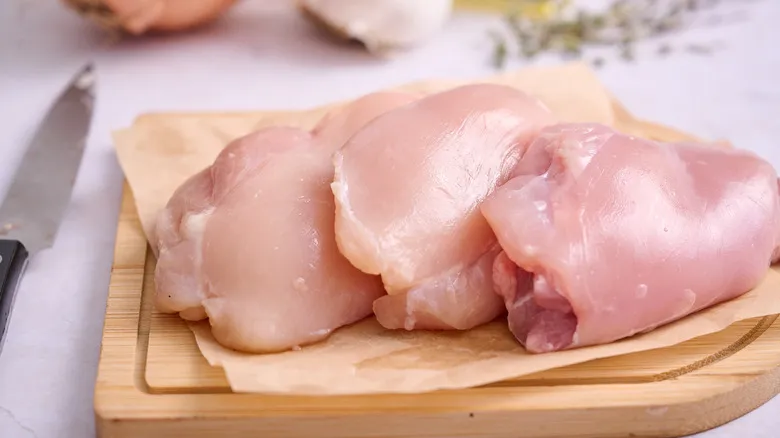The tools needed for deboning chicken thighs

You don't need a high-end kitchen or costly tools to debone chicken thighs. All that's required is a sharp knife and a cutting board. We suggest using a paring knife, particularly if it's your first time deboning. The smaller blade is perfect for cutting close to and beneath the bone, resulting in a cleaner cut and more usable meat. If you're comfortable with your knife skills, you can choose a chef's knife instead. Additionally, some optional but useful tools include kitchen shears for tackling tough skin and cartilage, and gloves to help prevent cross-contamination.
Trim the fat

Prepare the chicken thigh by removing any excess fat. This fat, which differs from the skin, will have a similar pale white-yellow hue and can be easily cut away using a knife or kitchen shears.
Michelle McGlinn/Chowhound
There's no need to remove all the fat at this stage; you can finish cleaning the thigh after deboning.
Score along the length of the bone

Turn the chicken over to reveal the bone. Begin on one side and carefully use your knife to cut along the bone, getting as close as you can while gradually detaching the bone from the meat.
Do the same on the opposite side of the bone, cutting into the meat until the bone is visible. Be careful not to cut all the way through the meat; stop once you can see the bottom of the bone.
Slice the bone away from the meat

Utilize the knife or your fingers to get underneath the bone, separating it from the meat.
Glide the knife along the underside of the bone and around its top and bottom to detach it from the thigh.
Remove the skin

Once you've deboned the chicken thighs, you have the option to take off the skin as well. To accomplish this, use your hands to gently pull the skin away from the top of the thigh, and use a knife to cut away any bits of skin that are still attached to the meat.
After removing the skin, tidy up the chicken thigh by trimming off any leftover fat and skin remnants.
The resulting chicken thigh, now clean, skinless, and boneless, should have a uniform pink hue and be roughly the size of your fist.
Using boneless chicken thighs

Chicken thighs are juicier and more tender than chicken breasts, making them a great substitute in many recipes that typically use the latter. Some of our favorite dishes featuring chicken thighs include chicken souvlaki, chicken adobado, and slow cooker chicken mole, all of which benefit from the moist and flavorful results that thighs provide. You can also use thighs in recipes like hearty white chicken chili, where they can be cooked quickly, shredded, and then simmered in the pot. Additionally, you can utilize your newly deboned thighs in place of bone-in, skin-on options, such as in our honey soy baked chicken thighs recipe. Opting for boneless, skinless thighs opens up a variety of possibilities, and preparing the thighs yourself gives you the flexibility to create these dishes whenever you like.
How to store chicken thighs

The simplest method for storing chicken thighs that you won't be using immediately is to place them in a resealable plastic bag. Whether they have bones or are boneless, transfer the chicken thighs into a gallon-sized bag, seal it tightly, and store it on the bottom shelf of your refrigerator. If you have a large quantity of chicken, consider wrapping smaller portions (like two or three pieces) in plastic before placing them in the resealable bag. This approach allows you to easily remove and thaw the chicken in portions when you're ready to use it.
How long chicken thighs last

You can keep chicken thighs in the refrigerator for one to two days. If you don't intend to use them within that time frame, you can freeze them for up to nine months.
Recommended

Why You Should Think Twice Before Cooking Popcorn In The Air Fryer

The Condiment You Should Avoid Buying At The Grocery Store

The Extra Sheet Pan Step You Should Take When Roasting Crispy Vegetables

It's Your First Time Cooking A Leg Of Lamb, Here's The Common Mistake To Avoid
Next up

